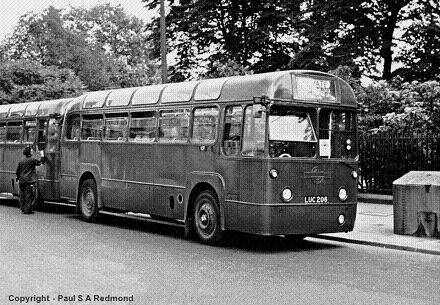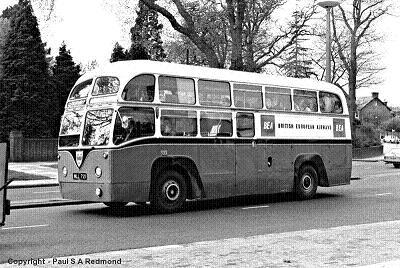 The
RF Story The
RF Story
Part 2 - A standard bus?
Page last updated 24 December
2014
Short RF6, looking a
little worse for wear, works from Chalk Farm garage with another
Private Hire RF.
RF6 was based at Chalk
Farm between 1958 and withdrawal in 1963.
Photo © Paul Redmond
Despite the desire for standardisation, there was substantial
diversity in the RF fleet. When the RF was designed, the
maximum permitted length was still 27'6", to which size the
first order was built. These were the 25 Private Hire
RFs, with glazed roof panels. They were required urgently for
the Festival of Britain in May 1951, finally replacing the loss of
all but one of the sightseeing TF buses in the blitz. They
carried 35 seats and were distinguished by glazed cant panels in
the roof.
Delivered simultaneously
with the first RFs, but first with the newly-permitted 30'
length, were the 8' wide RFW class touring coaches.
These fifteen Regal IVs with spacious Eastern Coachworks
bodywork, again with glass roof panels and also opening
roofs, were unlike anything previously seen in the LT
fleet.
With approval now given for the operation
of single-deck buses of 30' length in London, the remaining RF
deliveries took advantage of this and carried an additional row of
seats. Capacity therefore increased to 39 on the Green Line
RFs and 41 on the buses, which achieved this by carrying two long
seats over the front wheels, for four passengers on the offside and
five on the nearside. The Green Lines had only one
sideways-facing seat and also were fitted with deeper
cushions.
 Not all RFs were alike under the paint, even when new.
Different specifications applied to the Green Line coaches, the
Central Area buses and the Country buses, the most obvious apart
from the seating being the doors. The Metropolitan Police
would not permit platform doors on red buses, as they were
considered to slow down boarding and therefore impede
traffic. Externally, Central buses had a route-plate holder
fitted over the entrance, whilst Green Line coaches carried side
route boards. Internally the copaches had luggage racks,
and heaters from new.
The initial delivery of the 675 30' RFs comprised 263 Green
Line coaches (September 1951 to October 1952), then 225 Central
buses (September 1952 to March 1953) and finally 187 Country buses
(March to December 1953).
Not quite an RF, but a Regal IV operated by
London Transport on behalf of BEA.
The BEA coaches carried no fleet numbers;
this is MLL721.
Photo © Paul Redmond
The final variant in the Regal IV story were the BEA
airport coaches, which were operated by London Transport and ran
between London and London Airport (Heathrow). These were
'one-and-a-half deck' coaches, with a raised rear saloon over a
large luggage compartment but a straight roofline that gave a high
and very airy front saloon. These 65 coaches had 37-seat
bodywork built by Park Royal to a width of 8'. They ran from
1952 until most were replaced by Routemasters with luggage
trailers in 1967.
LT did not use manufacturer’s model numbers,
but had its own system for coding the version of both chassis and
body, which enabled modifications to be identified. This was
of the form xRFy, where x was the chassis version and y the body
version. Minor variations used sub-codes, such as 1/2RF5/3,
which is what RF486 is now. 2RF
refers to the second, 30-foot long RF chassis type, 1/2RF to the
modification of the differential ratio to 4.57:1. Delivered as RF2,
a 30 foot body without doors, most red RF bodies were fitted with
doors and became RF5/3 (RF5 being the original classification of
the OMO Country RFs). The private hire RFs were 1RF1s,
RFWs were 3RF3s and the BEA coaches 4RF4s. More details of
the classification are given in the Appendix.
|